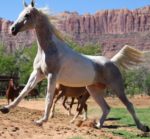In some areas of the country temperatures are warming a little and ground can thaw during the day. Spring will come sooner or later to most of us and that means more moisture in the soil, more mud and wetness that can provide perfect breeding ground for bacterias and fungus and therefore inevitably also in the grooves and sulcrus of the hooves of our horses. And together with the bacterias comes the thrush!
What is thrush exactly?
It’s a bacterium that survives without the presence of oxygen, thrives in moisture and will eat your horse’s frog. It can almost always be prevented with daily hygiene habits when taking care of your horse. It is common in the spring, or anywhere there is a moist climate or moisture in the ground. It is also found in horses hooves that have unclean areas to stand in, like dirty stables or corrals with lots of muck.
Generally speaking, thrush is not deadly, but there have been times in the past where a horse has had to be put down due to the condition getting out of hand. Studies suggest that in minor cases, it takes about three days for thrush to arrive and have visible symptoms, and about three days to get rid of it with proper measures and treatment.
The frog in your horse’s foot has two layers, the external skin called “horn tissue” and the vascular layer underneath. Beneath the inner, sensitive layers lies a pad-like “shock absorber” that reduces the impact for your horse’s hoof and limb. This is called the deep digital cushion.
If thrush shows up, you will see a black, puss-like discharge with a strange odor. The bacteria are actually attracted to the tissue that exists on the frog. If it goes on too long, it will form “pockets” that drill into the frog and eat away at the remaining healthy tissue. In a serious case, it is not uncommon to see bleeding as well. If this happens, you need to move your horse into a clean, dry and sanitary area and use an antiseptic foot wash with a betadine solution or a foot soak with warm Epsom salt water. After that, it is essential that the hoof and frog be treated with Hypozin to heal and prevent further occurrence.
Extreme case of thrush. The hoof is damage all the way into the digital cushion.
Prevention
Besides keeping horse stables and surroundings clean to help in preventing horse thrush, Hypozin can also be used to prevent thrush. When the frog becomes softer than usual, apply a thin layer of Hypozin.
After the easy application of Hypozin, the horse can either be left barefoot, shod with various hoof shoes or booted up with Easycare Gloves or Easycare Glue ons. While the horse is booted, the Hypozin can work even better to kill the thrush bacterias.
Here is a video on how to apply Hypozin:
At Global Endurance Training Center we test products so you do not have to. We only recommend and offer products in our online store that were thoroughly tested, proven and used successfully on our own horses all year long.
Hypozin is being produced by Multicore in the Netherlands. GETC is the exclusive importer and distributor for Hypozin within the USA.
Hypozin – because it works.
Now available at an bargain introductory price at GETC online store



Thanks for the marvelous posting! I actually enjoyed reading it, you may be a great author.
I will always bookmark your blog and will often come back someday.
I want to encourage you continue your great writing, have a
nice afternoon!
Also visit my blog post: sporeshot